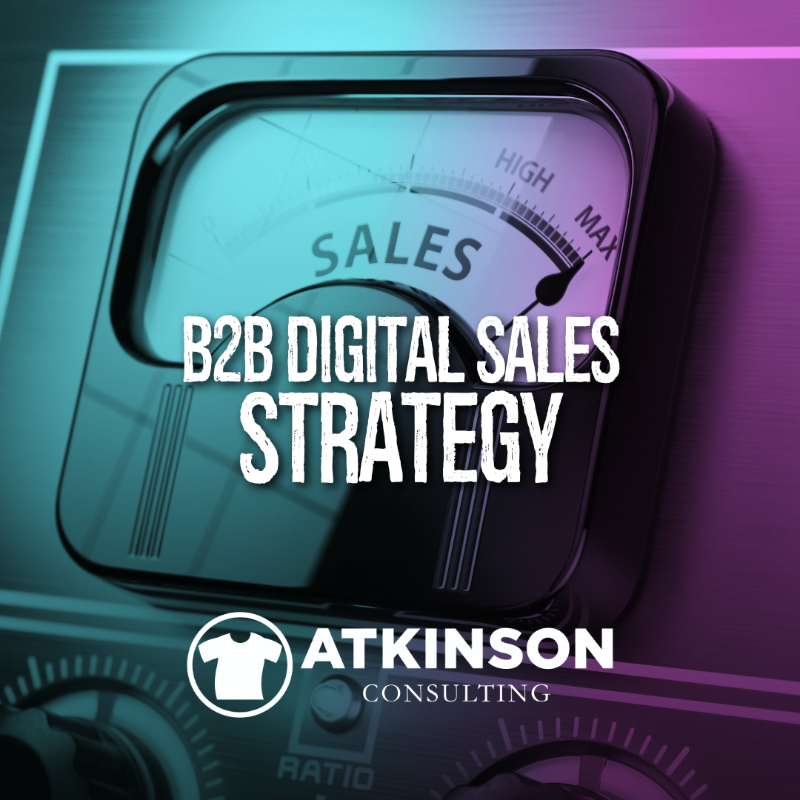The coronavirus pandemic event is shifting how B2B buyers and sellers interact. Are you ready for the next normal?
As the COVID-19 virus destroys both the health of people and business revenue around the world, it is crystal clear that the conditions we face are in a critical state. Selling anything right now is extremely difficult, but there are some sparks of life in a few different corners. Things are starting to emerge.
If you stop and think about it, the way B2B business was handled before the pandemic was moving to a digital strategy anyway. Remember all of those “Retail Apocalypse” articles and commentary for the last couple of years?
This isn’t anything new.
Right now there is a storm brewing in how anyone involved in the B2B game is handling things. There are three main areas of focus:
- Businesses trying to keep their company alive during this crisis.
- Strategizing on what to do immediately after the “re-opening”
- Reimagining the next normal
If you sell to anyone with a B2B strategy, where is your mindset right now?
What are you chatting about on your last Zoom call or social distancing meeting with your team? Are you preparing for the future?
Companies Are Buying
I was on a call with a business owner last week and the conversation focused on one thing.
Their market sector was buying, but not from them.
They are a large contract apparel decorator, and it was very frustrating for them to learn that an apparel wholesaler has started up several decoration facilities around the country and is now going after their clients with a brand-new mission intensity and focus.
Talk about frustrating.
But here’s the point: When business in other company’s sales pools shrinks, don’t be surprised if the bigger fish start gobbling up different sales opportunities in their channel to stay alive.
For the contract decorator, they were upset that they spent over $5 million dollars a year with this distributor. But if you look at it from the distributor’s point of view, if they target this market sector as a whole, $5 million dollars is a drop in the bucket to what they possibly could gain. They are completely ok with sacrificing this long term customer, as they see a bigger opportunity in the market. Which is probably a play to keep their venture capital funders happy.
Queue the “Businesses trying to stay alive during the crisis” theme song.
Obviously, those sales are there. They simply didn’t go to where this one shop had hoped.
Question: How Are You Competing?
This begs the question, “How are you competing?” Are you leading with pricing first? Or, can you articulate your value to your customer better?
Just how solid is your relationship? Don’t be the last to know in that conversation.
If there is one thing that the coronavirus pandemic has taught us it has shown the need to be more human, but connect with a solid digital structure.
You don’t have to be a rocket scientist to know that more transactions are being conducted online than ever before.
How are you doing this yourself during the shelter-in-place rules? What software, websites, apps, or digital tools are you using when you buy anything for your own family? You need easy to use and frictionless tools.
Value Now Starts With Empathy
What do we value right now?
Help.
If you sell to the B2B market at all, how are you reaching out to your customer base and offering any type of assistance? Are you asking how they are doing? Are you using video for sales calls to secure a human-to-human relationship?
Maybe you have always been a price first type of company. Not much interaction on a personal level. This is where the big fish are going to eat your lunch.
Instead, learn to lead with solving people’s problems first. Value goes beyond what the price is listed on the quote if you are providing answers or other expertise too.
Trust me, there are plenty of B2B opportunities out there with some sort of problem to solve. Asking better questions and providing a higher value is a fantastic tactic to deploy. Just being the person that can knock out a quote is a license to lose that business when times are tough.
That’s commodity level thinking.
Your Reopening
Around the globe, some businesses are getting things fired back up. Reopening is happening. This may or may not be a good thing depending on your point of view and geographic area. I’m not getting into the politics of this either, so save your comments.
What I want you to focus on is your business. What does it mean to “reopen”? Not for you, but for your B2B customers.
Of course, you could ask them directly, but if you can’t pepper them with questions to discover their struggle at least pretend to be in their shoes. What are they concerned about? Can you name their top two or three challenges?
For these businesses, what’s going on right now and will be in place for the near future are more:
- Digital interactions. This means their online sales, not yours. These need to use a website or app. What will change in how they do business? Sales, marketing, people, or support? What are they offering? Where can you help?
- Self-Service. Right now, nobody wants to interact with anyone’s staff. Or, at best, they want to keep it to a minimum. How will this change the way your customer, or even you, handles the workload? What will they need to make this work?
- Personal Experience. We want comfort right now. It feels nice to be acknowledged and named. Watch this Dan Pink video. How grateful are you to your customers? I love this video because of his technique of using the “Mental Subtraction of Positive Events”, is exactly the mode everyone is living right now. Can you help your customers acknowledge their customers? Are they even thinking about this?
Understanding
Do you know your customer’s biggest pain points, frustrations, and fears? In the B2B world, the biggest problem with doing business with another company is focused on the big three:
Length of the ordering process
Think about why Amazon works so well. It is ridiculously easy.
- How many steps are your customers having to wade through to order
- Have you mapped out and defined this process?
- What can you do to eliminate a step or two to make it easier?
From start to finish how many days or weeks go by while you deal with someone on their idea? Have you ever mapped out the average cycle time for your sales transactions? How many times are you calling, emailing, texting, with information or approvals or changes?
I’m tired just thinking about it. What must it be like for your customer?
Can you work on making this easier?
Difficulty finding or understanding products
Just how many shirt colors and styles are there? Your B2B customers have to see you as an expert. Are you asking clarifying questions to guide the discussion into targeted SKUs that will work for the project, or are you shoving an inch and a half thick catalog at them and saying, “pick whatever you want?”
- Can you pre-choose a “Good, Better, Best” best practice for apparel choices for any other category of items that you sell? This can be based on ease of decoration, availability, transit times to you, and most importantly, the profit margin for your business. Is this ready to go in a branded .pdf or online link?
- If everyone will be placing orders virtually, how are you detailing fit and finish? The softness of the shirt? Will you ship samples? Will you charge for them? Detail this process.
- This industry has a lot of vocabulary that your customers probably don’t understand, nor do they even want to learn. 30-singles. Flash cure. Placket. Running stitch. Dye migration. Can you either educate in a non-threatening way or talk in layman’s terms?
Problems When Ordering
Someone once said that “this would be a great industry if it weren’t for our customers”.
Joking of course, but you get the idea.
This is the technical side of getting sales handled. Your process. Have you ever considered how many of your problems in the shop can be traced back to the information (or lack of information) from the customer?
Ambiguity breeds problems.
How dialed in is your ordering and sales information platform? How many of your key problems may be eliminated if your company did a better job of this earlier in the process?
- Nobody understands your problems better than you. Yet, many shops have never charted this out or dug in with the continuous improvement effort to be more effective. Do yourself a huge favor and start creating a database for your top challenges. Backtrack and see if you could have obtained better information earlier in the process to eliminate that bottleneck or error.
- How many of your problem orders were from lower profit jobs, or work that you are not fully capable of handling? Not all sales orders are good orders to have. When you dig in, can you unearth the financial impact of not taking on some facet of what you sell? What if the amount of time, energy, and resources that you spend each year that are devoted to non-profitable or problematic jobs were eliminated? Then, with that extra time and money, you could shift into finding and obtaining better orders that make better sense for your business. Can you work half as hard for twice as much? You better believe it.
- Did you build your website yourself to save money? Is it really working? Many business owners don’t consider having the proper tools for the job a justifiable expense. Shift your mindset. It’s not what it costs you that matters, it is how much money could you make instead. If you are trying to sell online, are you using the best tools for the job, or something that “costs you less” because you don’t want to spend the money? That is like trying to win an automobile race, but instead of dropping in a finely tuned racing engine in, you strap in a few hamsters and some cheese. Yep. It’s cheaper.
Lunch Field Trip
This week I want you to take a field trip and go to Chik-Fil-A for lunch. Go at a peak time, not at 3:00 in the afternoon. Try it at lunch, when they are the busiest. The line of cars will be backed up twenty or thirty deep.
If you want to experience how to run a popular business, take some notes.
Here’s why it works so well:
- Outside, in the parking lot, in all weather conditions, will be numerous restaurant staff members.
- All of them will be friendly. Despite wearing PPE, you can tell they are smiling. They greet you happily and are sincerely pleased to see you.
- All use technology. They are connected with earphones and a mic.
- Multiple people roam the line taking orders. They have the menus printed and hanging off the device they use to key in your order.
- They ask for your name. They also use it in conversation with you while you are choosing what you want.
- Chik-Fil-A has a limited menu. This is about speed.
- They also don’t discount. There is not a value meal. This is about profit.
- The first employee takes your order. As you get closer another employee takes payment. This is handled with a credit card reader on an extended selfie-like stick. You swipe your own card. Nobody touches anything.
- When you say Thank You, every staff member at Chik-Fil-A is trained to say “My pleasure” as the response. I think that is really nice. This is culture.
- When you drive up to the window your food will be ready and is not handed to you directly, but offered up on a tray. There is no waiting.
- Despite there being twenty or thirty cars in line, this entire process takes only a few minutes. Maybe one song on the radio.
If you really want to take your field research to another level, find another drive-thru with a different food chain. The differences will be glaring and obvious.
Why is this an important lesson?
Chik-Fil-A recognizes that speed coupled with safety matters. This is the time we are living in now. Take this same idea and rework your processes for what you are doing in the B2B market that you cater to.
What you pivot to has to matter to your customers first. Want to build trust, loyalty, and raving fans? Look at the Chik-Fil-A drive-thru as a model.
What could you change in your own business with how you sell to the B2B market?
“Everyone seems to think that digital technology devoids the medium of content, but that’s not true at all. If anything, it broadens the content.” – George Lucas
“Social and digital media is a bullet train, and that bullet train is not coming home.” – Howard Schultz
“Digital fluency is about basic skills.” – Julie Sweet





